This was published 9 years ago
Oxford Walking Tours: Lewis Carroll's inspiration
A young girl by the name of Alice Liddell and the beautiful Oxford waterways inspired Lewis Carroll's most famous works, writes Steve McKenna.
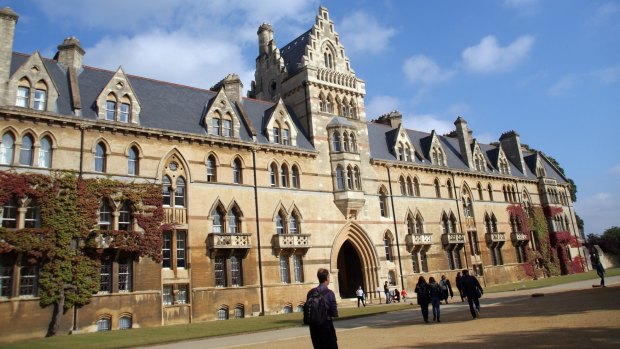
World famous university: Alumni of Oxford's Christ Church College include Albert Einstein and W.H. Auden.Credit: Steve McKenna
It is a glorious autumnal day in Oxford. The sky is blue, the air is fresh and the back of my neck and arms are being slowly toasted by the sun as we cruise along the River Thames, passing the odd kayaker, canoeist, rowing team and fellow pleasure cruisers. Skirting by tree-lined banks, which are hugged by chains of narrowboats, we see joggers, walkers and squirrels stretching their legs, and ducks, swans and geese fraternising and swaggering along. The bucolic serenity – pierced, only mildly, by the gentle hum of our boat engine and the sound of the prow cutting through the water – lulls me into a trance, and before I know it, I'm daydreaming, away with the fairies.
To be fair, this stretch of the Thames has form when it comes to transporting people from the quotidian to the quixotic. In the mid 19th century, a maths don called Charles Lutwidge Dodgson would tell fantastical stories to the children of his friend and boss, Henry Liddell, while out rowing along the river.
One of the children was named Alice. Dodgson was better known by his pseudonym – Lewis Carroll. His weird and wacky tales morphed into Alice's Adventures in Wonderland – a favourite book of Queen Victoria; one that next year (2015) marks the 150th anniversary of its publication.
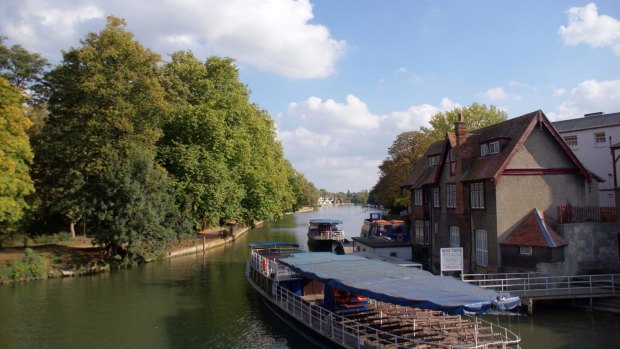
Historic waterway: In the mid 19th century, Charles Lutwidge Dodgson would tell weird and wacky stories to the children of his friend and boss, Henry Liddell, while out rowing along this stretch of the River Thames.Credit: Steve McKenna
"If it wasn't for Oxford's waterways, there probably would be no Alice in Wonderland," says Mark Davies, a local social historian whose own book, Alice in Waterland, looks at the essential role played by the Thames – and Oxford – in the story's creation.
Keen to discover more following my soothing boat trip, I join one of Davies' tailor-made "Alice in Oxford" walking tours, which offer an absorbingly photogenic insight into how this 'City of Dreaming Spires' inspired not just Carroll, but a raft of other fantasy writers, from C.S. Lewis to Philip Pullman.
We meet at Alice's Shop. Said to be where Alice Liddell would buy sweets in her youth, the shop appeared in Through the Looking-Glass, Carroll's 1871 sequel to Wonderland. Today, the little shop buzzes with Alice aficionados, who browse and buy souvenirs such as clocks, cards, lockets, pendants and tea towels branded with characters like the Mad Hatter, Humpty Dumpty, the Cheshire Cat, Tweedledee and Tweedledum and Alice herself. There are cups labelled: "Drink Me!" and earrings shaped like the White Rabbit's pocket watch. The flurry of foreign languages whispered inside this snug cubbyhole – from Japanese to Portuguese – hint at Alice's global appeal.
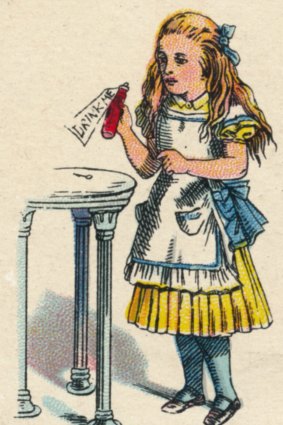
Surreal story: Alice's Adventures in Wonderland was printed in 1865, complete with illustrations by John Tenniel. Credit: Getty Images
Crossing St Aldate's Street, our tour group enters the magnificent grounds of Christ Church College. The grandest component of Oxford's world-famous university, Christ Church has an illustrious alumni, comprising 13 British prime ministers, and countless big names from the arts and sciences, including Albert Einstein, W.H. Auden and one Charles Dodgson.
Born in the Cheshire village of Daresbury, Dodgson studied mathematics and classics at Oxford and ended up teaching here after his graduation, having won favour with Henry Liddell, Christ Church's new dean.
Ambling along, we pass the college's blooming beds of flowers, rugby fields, meadows, wooded avenues and grandiose honey-shaded buildings (including the Great Hall, which starred as Hogwarts in the Harry Potter movies and whose stained glass windows depict characters from Carroll's Wonderland).
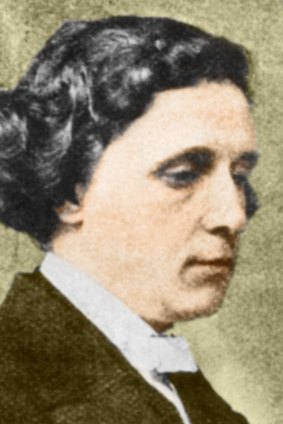
Literary hero: Charles Lutwidge Dodgson was better known by his pseudonym – Lewis Carroll.Credit: Getty Images
Davies points out where Dodgson first met the Liddell children. A keen amateur photographer, he was snapping Christ Church cathedral on his new-fangled Thomas Ottewill Registered Double Folding camera when a six-year-old Alice and her two sisters asked to be photographed.
Dodgson agreed, heralding the start of a fruitful friendship with the children; one that had the approval of the dean, his wife and the kids' governess, Mary Prickett – the inspiration, some say, for the 'thorny' Red Queen from Wonderland.
While Carroll's stories were other-worldly in nature, he would use familiar things and people as ingredients – and the fact that he never revealed the true inspirations behind his characters has sparked endless speculation.
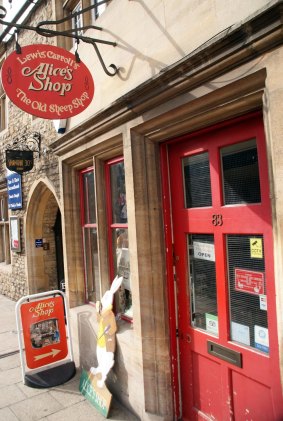
Fan zone: Alice's Shop, which today sells Alice in Wonderland souvenirs, is said to be where Alice Liddell would buy sweets in her youth.Credit: Steve McKenna
Davies, whose research included mining the published diaries and memoirs of Carroll and Alice, tells us that the scene in the first Wonderland book where Alice plays croquet with the Queen of Hearts was possibly based on a real-life game that Alice Liddell enjoyed with the Prince and Princess of Wales, who were regular visitors to Oxford.
The book's dodo, meanwhile, was likely a self-caricature of Dodgson. He had a pronounced stutter, so when he introduced himself, it sounded like: "Do-do-dodgson". Incidentally, Oxford's Museum of Natural History contains the world's most complete remains of a single dodo, plus a 17th century painting of the bird.
We tread a footpath between Merton College and Merton Field. Dubbed "Dead Man's Walk", it used to lead to a medieval Jewish cemetery, which later evolved into a rose garden. It nestles beside the city's Botanic Garden, which was founded in AD1621 for the study of medicinal plants, and was a key location in Phillip Pullman's His Dark Materials trilogy. One of the gardens' benches has "Lyra + Will" carved into it in tribute to Pullman's lead characters, Lyra Belacqua and Will Parry.
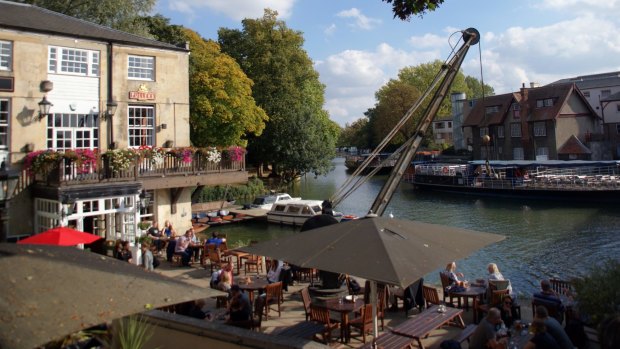
Renovated boatyard: The head of the river pub at Folly Bridge faces Salter's Steamers which dates back to 1858.Credit: Steve McKenna
This relaxing garden was a cherished hideaway for J.R.R. Tolkien. A professor at Oxford's Pembroke College, Tolkien was a contemporary of C.S. Lewis, a tutor at Magdalen College (whose cloistered buildings are thought to have influenced his Chronicles of Narnia tales). Other literary figures to have studied or taught at Oxford include Graham Greene, T.S. Eliot, Philip Larkin, Evelyn Waugh, John Updike, Kingsley and Martin Amis, John Le Carre, Oscar Wilde, Samuel Johnson and T.E. Lawrence.
An avid walker, Carroll would regularly stroll beside the Cherwell River, one of the tributaries of the Thames (which is also traditionally known as the River Isis in Oxford; but not so much nowadays). We saunter along the Cherwell's sun-dappled riverside trail, in the shadow of chestnut, maple and alder trees, and pass students ogling books, penning notes and picnicking. As birds chirp and tweet and golden leaves are scrunched underfoot, it feels every inch the rural idyll - hard to believe we're just a kilometre from Oxford's lively centre (though, glancing across the meadows, past the grazing cattle, we glimpse the city's iconic 'dreaming spires').
A little further along, Davies stops our group and points across the Thames. "Do you see that house? The three-storey one?"
Perched on arches, with a stream flowing beneath it, Grandpont House was the mansion of Thomas Randall, an esteemed Oxford tailor, who was also apparently known locally as 'the hatter'.
Alice knew Mr Randall and took Rover, his retriever, out for walks. This 'hatter' would occasionally host tea parties, says Davies, with a wry smile.
Our pleasant walk ends by Folly Bridge, the launchpad for the myriad meandering rowing trips-cum-picnic excursions that Carroll took Alice and her sisters on. The river is lined with influential Wonderland spots, including the villages of Godstow, Nuneham and Sandford, where, one afternoon, a heavy downpour forced Carroll and the girls to flee their boat and seek refuge. This episode is thought to have inspired the 'Pool of Tears' chapter in which Alice's tears threaten to overwhelm Wonderland.
"Carroll would often take the girls out for six miles or more," says Davies. "It would have been easy for the children to get bored, so he had an opportunity – in fact, an obligation – to keep the girls happy."
Alice badgered Carroll to write his stories down, and in 1864, he presented her with the manuscript of Alice's Adventures Under Ground.
After friends read, and loved, this surreal tale of a girl who tumbled down a rabbit hole and fell so far that she feared she was going to end up in New Zealand or Australia (or 'the antipathies', as Alice thought they were called), Carroll was urged to publish to a wider audience. Alice's Adventures in Wonderland was printed the following year, complete with illustrations by John Tenniel. Alice was no doubt pleased. In the story, Alice famously pondered "what is the use of a book without pictures or conversations?"
Alice and Carroll eventually drifted apart. She married cricketer Reginald Hargreaves; Carroll was a lifelong bachelor, a fellow at Christ Church til his death in 1898, aged 65. After her husband died in 1926, financial worries forced Alice to sell her copy of Alice's Adventures Under Ground, fetching about $30,000 at a Sotheby's auction.
We take refreshments at the Head of the River pub by Folly Bridge. Housed in a renovated boatyard, with a lovely outdoor terrace, the pub faces Salter's Steamers – one of the family-owned tour operators that cruise up and down the river. Salter's dates back to 1858 – the year, it is believed, that Carroll first met Alice.
FIVE OTHER ALICE-INSPIRED LOCATIONS
1. LLANDUDNO. Young Alice Liddell holidayed with family in this North Wales seaside resort, which recently launched the 'Follow the White Rabbit' digital app. This interactive trail leads visitors on a tour of Llandudno's landmarks, and features quirky nods to Wonderland's characters; alicecic.co.uk
2. CORNWALL. Tucked inland from the Cornish coast, and hedged by beautiful landscaped gardens, Antony House is an early 18th century National Trust mansion which starred in several scenes of Tim Burton's 2010 visual blockbuster, Alice in Wonderland;
3. LONDON. Oxford's Christ Church College has occasional Mad Hatter-style tea parties, but London's Sanderson Hotel is renowned for its daily Alice-influenced afternoon teas. For twilight drinks, Shoreditch duo The Looking Glass and Callooh Callay are two of the city's coolest Wonderland-tinged cocktail bars; visitlondon.com
4. DARESBURY. This leafy village, 25km from Liverpool, close to the Manchester Ship Canal, has a Lewis Carroll visitor centre, set in All Saint's Church, where the author's father was a vicar; lewiscarrollcentre.org.uk
5. TOKYO. For an example of Alice's worldwide appeal, check out Alice's Fantasy Restaurant in Japan's neon-charged capital. You'll find psychedelic decor, coquettish waitresses kitted out like Alice and snacks laden with 'Eat Me' signs; alice-restaurant.com
Steve McKenna was a guest of Visit Britain, Oxford River Cruises and the Randolph Hotel
TRIP NOTES
GETTING THERE
Trains for Oxford leave London's Paddington Station every 10-20 minutes and take about an hour; firstgreatwestern.co.uk.
STAYING THERE
A former prison, the Malmaison has been converted into a luxury hotel inside the spruced-up Oxford Castle Quarter. Bed and breakfast priced from around £209 ($381); malmaison.com/locations/oxford/
Famed for its Morse Bar, which is dedicated to the protagonist in Colin Dexter's Oxford-based Inspector Morse novels, the elegant Randolph Hotel is a stone's-throw from Trinity College. Bed, breakfast and dinner packages from £174; macdonaldhotels.co.uk/our-hotels/macdonald-randolph-hotel/
WALKING THERE
Mark Davies' guided walking tours are priced £40 ($72) per group for one hour; £70 for two hours; £100 for three; oxfordwaterwalks.co.uk
MORE INFORMATION
Sign up for the Traveller Deals newsletter
Get exclusive travel deals delivered straight to your inbox. Sign up now.